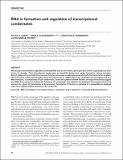RNA in formation and regulation of transcriptional condensates
Author(s)
Sharp, Phillip A; Chakraborty, Arup K; Henninger, Jonathan E; Young, Richard A
DownloadPublished version (3.574Mb)
Publisher with Creative Commons License
Publisher with Creative Commons License
Creative Commons Attribution
Terms of use
Metadata
Show full item recordAbstract
<jats:p>Macroscopic membraneless organelles containing RNA such as the nucleoli, germ granules, and the Cajal body have been known for decades. These biomolecular condensates are liquid-like bodies that can be formed by a phase transition. Recent evidence has revealed the presence of similar microscopic condensates associated with the transcription of genes. This brief article summarizes thoughts about the importance of condensates in the regulation of transcription and how RNA molecules, as components of such condensates, control the synthesis of RNA. Models and experimental data suggest that RNAs from enhancers facilitate the formation of a condensate that stabilizes the binding of transcription factors and accounts for a burst of transcription at the promoter. Termination of this burst is pictured as a nonequilibrium feedback loop where additional RNA destabilizes the condensate.</jats:p>
Date issued
2022Department
Massachusetts Institute of Technology. Department of BiologyJournal
RNA
Publisher
Cold Spring Harbor Laboratory
Citation
Sharp, Phillip A, Chakraborty, Arup K, Henninger, Jonathan E and Young, Richard A. 2022. "RNA in formation and regulation of transcriptional condensates." RNA, 28 (1).
Version: Final published version